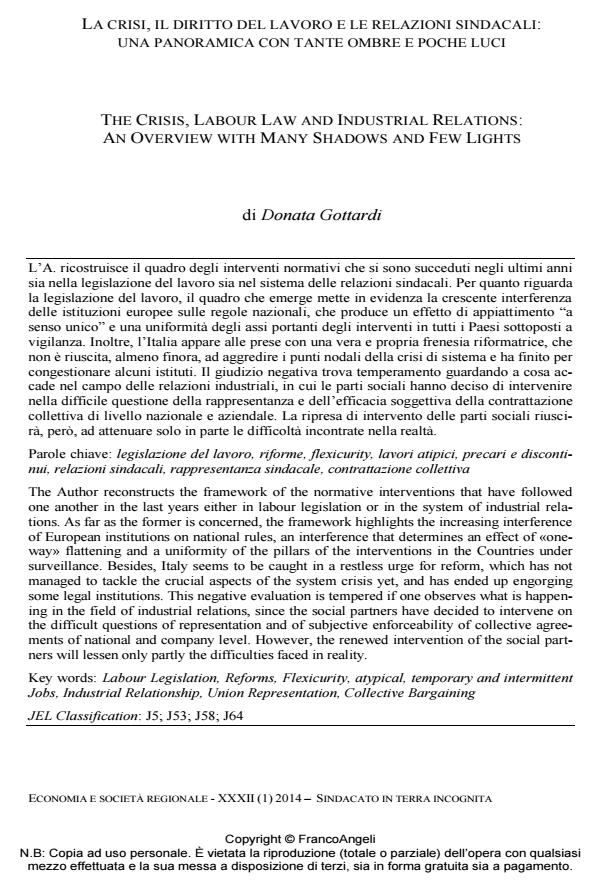The crisis, labour law and industrial relations: an overview with many shadows and few lights
Journal title ECONOMIA E SOCIETÀ REGIONALE
Author/s Donata Gottardi
Publishing Year 2014 Issue 2014/1 Language Italian
Pages 18 P. 7-24 File size 721 KB
DOI 10.3280/ES2014-001002
DOI is like a bar code for intellectual property: to have more infomation
click here
Below, you can see the article first page
If you want to buy this article in PDF format, you can do it, following the instructions to buy download credits

FrancoAngeli is member of Publishers International Linking Association, Inc (PILA), a not-for-profit association which run the CrossRef service enabling links to and from online scholarly content.
The Author reconstructs the framework of the normative interventions that have followed one another in the last years either in labour legislation or in the system of industrial relations. As far as the former is concerned, the framework highlights the increasing interference of European institutions on national rules, an interference that determines an effect of «oneway » flattening and a uniformity of the pillars of the interventions in the Countries under surveillance. Besides, Italy seems to be caught in a restless urge for reform, which has not managed to tackle the crucial aspects of the system crisis yet, and has ended up engorging some legal institutions. This negative evaluation is tempered if one observes what is happening in the field of industrial relations, since the social partners have decided to intervene on the difficult questions of representation and of subjective enforceability of collective agreements of national and company level. However, the renewed intervention of the social partners will lessen only partly the difficulties faced in reality.
Keywords: Labour Legislation, Reforms, Flexicurity, atypical, temporary and intermittent Jobs, Industrial Relationship, Union Representation, Collective Bargaining
Jel codes: J5; J53; J58; J64
- Aa.Vv. (2013). In-flessibili, Guida pratica della Cgil per la contrattazione collettiva inclusiva e per la tutela individuale del lavoro. Roma: Ediesse.
- Aa.Vv. (2012). La riforma del lavoro del Governo “tecnico”, Lavoro e Diritto, 3-4.
- Aa.Vv. (2012). Contrattazione di prossimità e art. 8 della legge n. 148/2011, Rivista Giuridica del Lavoro, 3.
- Bavaro V. (2013). Azienda, contratto e sindacato. Bari: Cacucci.
- Brollo M., a cura di (2012). Il mercato del lavoro. Vol. VI del Trattato di diritto del lavoro, diretto da Persiani M. e Carinci F. Padova: Cedam.
- CE (2006). Libro verde. Modernizzare il diritto del lavoro per rispondere alle sfide del XXI secolo. COM(2006) 708. Bruxelles.
- CE (2007). Verso principi comuni di flessicurezza: Posti di lavoro più numerosi e migliori grazie alla flessibilità e alla sicurezza. Comunicazione della Commissione al Parlamento europeo, al Consiglio, al Comitato economico e sociale europeo e al Comitato delle Regioni, del 27.6.2007- COM(2007) 359 definitivo. Bruxelles.
- CE (2008). Direttiva del Parlamento europeo e del Consiglio relativa al lavoro tramite agenzia interinale. Strasburgo: 19 novembre, n. 2008/104/CE. Pubblicata nella G.U.U.E. 5 dicembre 2008, n. L 327 ed entrata in vigore il 5 dicembre 2008. Recepita con dlgs 2 marzo 2012, n. 24.
- Ces (2013). Contestare le misure di austerità attraverso la via vertenziale. Documento di orientamento del Comitato esecutivo. CES\CE204\FR/10. Bruxelles, 22 e 23 ottobre <www.etuc.org>.
- Consiglio d’Europa (2014). European Social Charter (revised), European Committee of Social Rights. Conclusions 2013 (Italy). Strasbourg. January.
- Gottardi D. (2013). Nota a contratto: l’accordo Pometon S.p.a. nello specchio rotto delle relazioni sindacali nel settore metalmeccanico, Lavoro e Diritto, 2: 269-282, DOI: 10.1441/73806
- Gosetti G., a cura di (2011). Lavoro e lavori. Strumenti per comprendere il cambiamento e Il lavoro: condizioni, problemi, sfide. Milano: FrancoAngeli.
- Ministero del Lavoro e delle Politiche Sociali 2014. Il primo anno di applicazione della legge 92/2012. Quaderno n. 1, gennaio.
- Leccese V. (2012). Il diritto sindacale al tempo della crisi. Intervento eteronomo e profili di legittimità costituzionale relazione, Giornale di Diritto del Lavoro e Relazioni Industriali, 136(4): 479-525, DOI: 10.3280/GDL2012-136001
- Napoli M., Ferrante V., Corti M., Occhino A. (2012). Nuove tendenze nelle fonti del diritto del lavoro. Milano: Vita e pensiero.
- Nogler L. e Marinelli M., a cura di (2012). La riforma del mercato del lavoro. Torino: Utet.
- Veneto Lavoro (2014). Uno stallo insidioso. Stillicidio dei posti di lavoro e stress delle politiche di contrasto. Rapporto 2013. Milano: FrancoAngeli.
- Zoppoli L. (2012). Flex/insericurity. La riforma Fornero (l. 28 giugno 2012, n. 92) prima, durante e dopo. Napoli: Editoriale Scientifica.
Donata Gottardi, La crisi, il diritto del lavoro e le relazioni sindacali: una panoramica con tante ombre e poche luci in "ECONOMIA E SOCIETÀ REGIONALE " 1/2014, pp 7-24, DOI: 10.3280/ES2014-001002